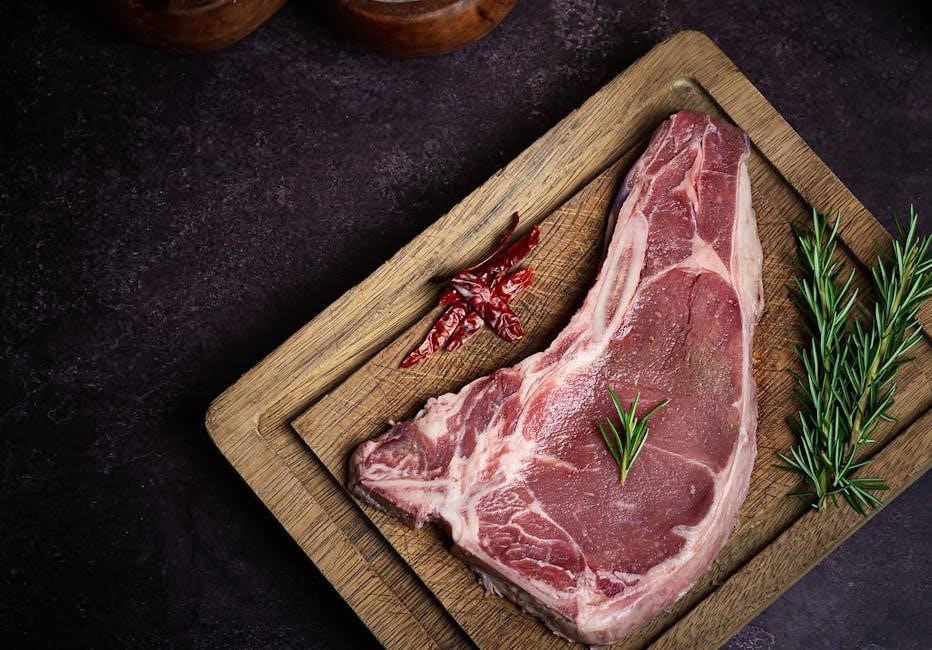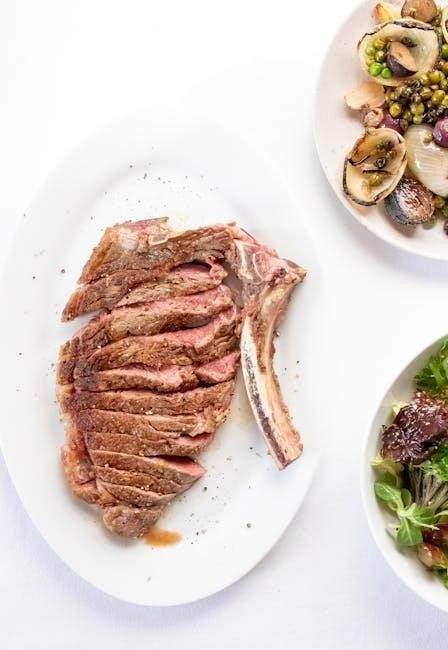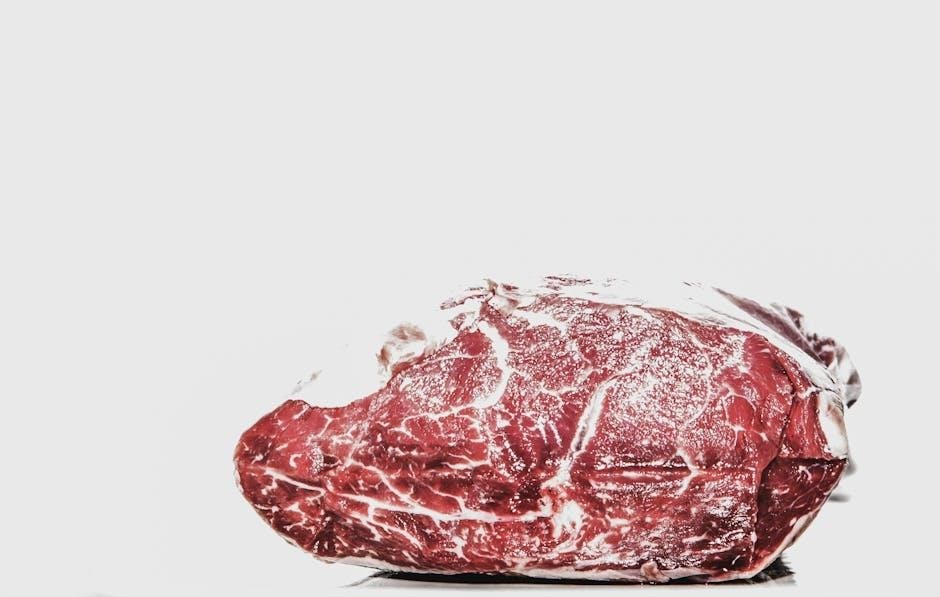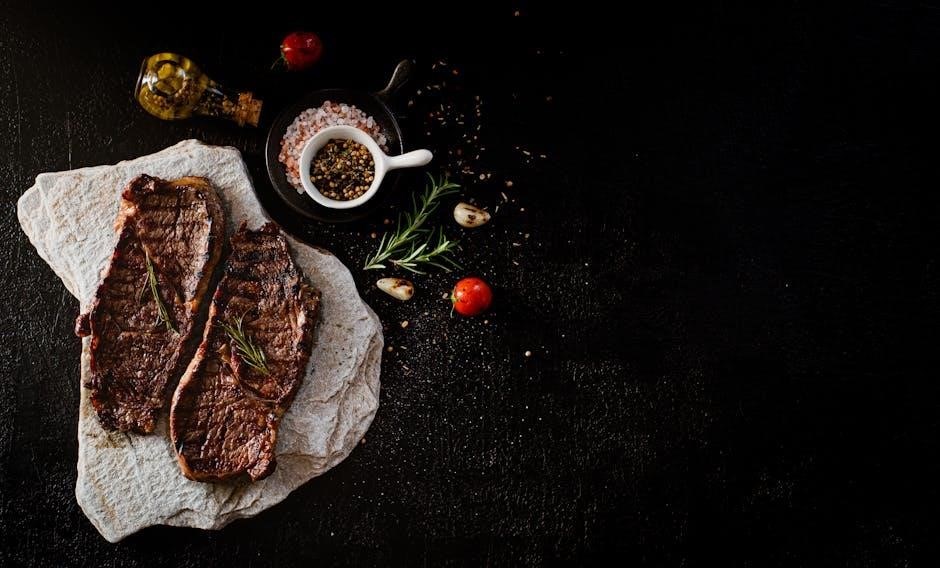Learning about beef cuts is essential for chefs and home cooks, using a
beef cuts diagram
to identify different cuts and their locations on the animal, with clear labels and illustrations.
Overview of Beef Cuts
A beef cuts diagram is a valuable tool for understanding the different cuts of beef, with various sections and labels to identify specific cuts and their locations on the animal. The diagram typically includes primal cuts, such as the chuck, rib, and loin, as well as sub-primals and individual cuts like steaks and roasts. By studying a beef cuts diagram, users can gain a deeper understanding of the relationships between different cuts and how they are related to each other. This knowledge can be useful for chefs, butchers, and home cooks, allowing them to make informed! decisions when selecting and preparing beef for meals. With a clear and concise diagram, users can quickly and easily identify the different cuts of beef and their characteristics, making it easier to cook and enjoy high-quality beef dishes. Using a diagram is an effective way to learn.
Importance of Understanding Beef Cuts
Understanding beef cuts is crucial for making informed decisions when purchasing and preparing beef, as different cuts have unique characteristics and uses. A clear understanding of beef cuts can help individuals select the most suitable cuts for their needs, ensuring the best flavor, texture, and value. This knowledge can also help to reduce food waste and improve cooking results, as users can choose the most appropriate cuts for their recipes. By studying a beef cuts diagram, individuals can gain a deeper understanding of the different cuts and their uses, allowing them to make the most of their beef purchases. This can be especially useful for chefs, butchers, and home cooks, who can use this knowledge to create delicious and memorable meals. Effective use of beef cuts can also enhance the overall dining experience. Using a diagram is an effective way to learn about beef cuts.

Types of Beef Cuts
Beef cuts are categorized into primal, sub-primal, and retail cuts, with each type having distinct characteristics and uses, using a
diagram
to identify them clearly always.
Primal Cuts of Beef
The primal cuts of beef are the initial cuts made on the carcass, dividing it into eight distinct sections, including the chuck, rib, loin, and round, among others.
These sections are then further divided into sub-primals and retail cuts, each with its own unique characteristics and uses.
A
beef cuts diagram
can be a useful tool for identifying and understanding the different primal cuts and their locations on the animal.
By studying the diagram, one can gain a better understanding of the relationships between the different cuts and how they are used in various recipes and cooking applications.
The primal cuts are the foundation of the beef cutting process, and understanding them is essential for any serious student of beef or culinary professional, using a diagram to guide them.
With this knowledge, one can navigate the world of beef cuts with confidence and precision, using a diagram as a reference.
Sub-Primal Cuts of Beef
The sub-primal cuts of beef are smaller sections of meat that are cut from the primal cuts, offering more versatility and variety in cooking and preparation.
These cuts are often used to create retail cuts, such as steaks, roasts, and ground beef, and are typically identified by their location on the animal.
A
beef cuts diagram
can help to illustrate the relationships between the primal and sub-primal cuts, making it easier to understand the different options available.
The sub-primal cuts are an important step in the beef cutting process, as they allow for greater precision and control over the final product.
By understanding the sub-primal cuts, cooks and chefs can better navigate the world of beef and create a wide range of delicious dishes, using a diagram as a guide to inform their decisions and ensure the best results, with clear labels and illustrations.

Beef Cuts Chart PDF
A downloadable
chart
provides easy access to beef cut information, with clear labels and illustrations, making it simple to navigate and understand different cuts and their locations.
Reading a Beef Cuts Chart
Reading a beef cuts chart can be a straightforward process, with the chart typically divided into sections, each representing a different primal cut of beef, such as the chuck, rib, and loin. The chart will also show the various sub-primals and retail cuts that can be derived from each primal cut. By using a beef cuts chart, individuals can gain a better understanding of the different cuts of beef and how they are related to each other. This knowledge can be useful for a variety of purposes, including cooking and meal planning. The chart can also help to identify the different characteristics of each cut, such as tenderness and flavor, allowing individuals to make informed decisions when selecting beef for cooking. Using a chart can simplify the process of navigating the complexities of beef cuts.
Understanding the Different Sections of a Beef Cuts Chart
A beef cuts chart is typically divided into several sections, each representing a different part of the animal, including the front, middle, and rear sections. The chart will show the primal cuts, such as the chuck, rib, and loin, and the sub-primals that are derived from them. Each section of the chart will also identify the various retail cuts that can be obtained from the sub-primals, such as steaks, roasts, and ground beef. By understanding the different sections of a beef cuts chart, individuals can gain a better appreciation for the complexity and variety of beef cuts. The chart can also help to identify the different characteristics of each cut, such as tenderness, flavor, and cooking methods. This knowledge can be useful for cooks, chefs, and anyone interested in learning more about beef cuts and their uses.

Certified Angus Beef
Meets strict quality standards with abundant marbling for exceptional flavor and tenderness always guaranteed with every certified cut of beef available in the market and online stores.
Quality Standards for Certified Angus Beef
Quality standards for Certified Angus Beef are very high, with a focus on marbling, which is the amount of fat that is dispersed throughout the meat. The
beef
must also meet certain standards for maturity, with most Certified Angus Beef coming from cattle that are between 12 and 24 months old. Additionally, the beef must be from Angus cattle, which are known for their high-quality meat. The quality standards are set by the American Angus Association, which is a non-profit organization that promotes the Angus breed. The standards are in place to ensure that Certified Angus Beef is consistently of high quality, with a focus on tenderness, flavor, and juiciness. By meeting these strict standards, Certified Angus Beef is able to provide a premium product to consumers. This is achieved through a rigorous inspection process;
Benefits of Choosing Certified Angus Beef
Choosing Certified Angus Beef provides several benefits, including consistent quality and tenderness. The
high-quality
beef is the result of a strict set of standards that ensure the beef is not only tender, but also flavorful and juicy. Additionally, Certified Angus Beef is a premium product that is rich in marbling, which enhances the flavor and texture of the beef. By choosing Certified Angus Beef, consumers can be confident that they are getting a high-quality product that is backed by a reputable organization. The benefits of choosing Certified Angus Beef also extend to the culinary experience, as the beef is well-suited for a variety of cooking methods and recipes. Overall, the benefits of choosing Certified Angus Beef make it a popular choice among chefs and home cooks alike, and its quality is unmatched in the industry with strict standards.

Grass Fed Beef and Sustainable Agriculture
Farmers raise cattle naturally without antibiotics using
grassfarming
methods for sustainable agriculture.
Benefits of Grass Fed Beef for Human Health
Grass fed beef offers numerous health benefits due to its nutrient-rich profile, with higher levels of omega-3 fatty acids and conjugated linoleic acid (CLA) compared to grain-fed beef. The
grassfarming
method used to raise cattle allows for a more natural diet, resulting in a better fatty acid profile and increased antioxidant content. This type of beef is also lower in calories and saturated fat, making it a popular choice for health-conscious consumers. Additionally, grass fed beef tends to be higher in vitamins A and E, as well as minerals like potassium and magnesium. Overall, incorporating grass fed beef into a balanced diet can have a positive impact on human health, with potential benefits including improved heart health and a reduced risk of chronic diseases. A
beef cuts diagram
can help identify the leanest cuts.